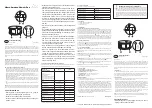
L-VIS User Manual
15
LOYTEC
Version 6.2
LOYTEC electronics GmbH
Display of data as numeric value, user-defined text or graphic elements,
horizontal and vertical bars, trend logs, or analog meters. A special element is
available to display date and time in form of digital or analog clocks.
Input of data via a numeric keypad, alphanumeric keyboard, direct drag of a bar,
selection from a dropdown list of texts or graphic elements, or touch and release
events (via action objects).
Mapping of values to colors, to allow an element to change any of its colors
depending on the current value of one or more data points.
Supports layers and transparency for all display elements. Layering is simply
defined by the order of objects in the tree view, which may be changed easily by
moving the objects around as required.
Support for numeric operations on data points, including a simple if/else
statement.
Possibility to change location and visibility of objects during device operation
based on data point values, allowing implementation of pop-up panels.
Template system for easy reuse of similar building blocks, with automatic
rerouting of data points to a different data set for each instance and limited
possibility for individual changes of position, color, or other properties at each
template instance. Make sure to read
Section 8.10
for an introduction, and
Section 9.15
for technical details about the template system.
Input voltage: 24V AC or DC
The LVIS-3E100, LVIS-3E11x, and LVIS-3MEx models (CEA-709) also provide:
Up to 1000 network variables and alias variables.
524 address table entries.
Up to 200 LonMark scheduler objects. Each scheduler object may control up to
64 data points in 107 daily schedules and manage up to 1000 entries in the
time/value table. Up to 256 value templates may be defined for each scheduler,
with a total data size of up to 1kB per value template.
An optional LonMark calendar object, defining exception days for the local
schedulers. The calendar object supports up to 100 date patterns with a total of up
to 1000 date entries.
Optional alarm server functionality provided by a SNVT_alarm_2 output NV
contained in the node object of the device.
FT-10/LPT-10 or Ethernet-IP852 operation selectable via a jumper on the device
or via a setting in the device configuration. When in FT-10 mode, the device can
still be reached via its Ethernet port for fast project download.
A lamp actuator object, to control the backlight from the network. This object
was used to control the internal relay on the older LVIS-3ECTB devices.
A switch object to provide a standard switch and dimmer function, as available
on other CEA-709 devices. The switch input for this object is the IN0 connector.
Both IN0 and IN1 inputs are also available as system registers, for internal use.
















































